When updating the interior (in the process of repair or while thinking about the concept) the question often arises: how can I update old interior doors? After all, they do not correspond to the new plan. Sometimes, besides, they are noticeably aged - paint peels off them, the coating peels off, the veneer is damaged somewhere. If the door retained its strength and functionality, and only its aesthetics suffered, then you can not buy a new one, but restore the old one. And money can be saved, and imagination applied. It is only necessary to choose the update method suitable for the door (and to your idea).
What's the point of updating old doors?
If the doors are outdated or lost their look, you can always buy new ones. And given the level of prices for interior doors, this will not be so expensive. Nevertheless, much can be said in support of the restoration:
- Saving. If you choose not the most budgetary doors, then still they cost money. Repair of old interior doors, especially if it is done by yourself, will cost much less.
- The value of old doors. It often turns out that old doors have artistic value or are simply expensive as a memory. In this case, restoration will be preferable.
- Uniqueness. After handwritten artwork, the doors become a unique product that can become a highlight of the interior.
- Self-realization. For many, working with hands is a kind of hobby, a hobby that can not only please the home, but also complement the family budget.
In general, any door can be put in order, except for the cheapest, low-quality ones, and those that are seriously damaged, so much that they have lost their structural strength. If you have to change not only the coating, but also a significant part of the frame, the sheepskin is not worth the cost and it is better to order a new door.
Preparing the door for transformation
Before updating the old interior doors with your own hands, you need to clean and prepare their surface. First of all, remove the old decorative coating. If the door was painted or varnished, then the old varnish and paint must be scraped off, if the door was covered with a film, it must be removed, if the veneer is finished and it is seriously damaged, it will also need to be removed.
Tools and materials that may be required:
- building hair dryer (it will help soften old paint or varnish),
- grinding machine (if the paint or varnish does not lend itself to a hair dryer and solvent, they will have to be removed by grinding),
- sand paper (with medium and fine grain),
- metal spatula (to scrape off paint or varnish),
- thinner (suitable for the type of varnish or paint with which the door is coated),
- brush (apply solvent),
- rags (wash off the paint and wipe the cloth after grinding).
So, we remove the door from the hinges and lay on the surface where the main work will be performed. It may be a table in the workshop, but there may also be two stools. The accessories will have to be removed completely - hinges, handles, latch or lock. If it is old and very valuable, it will need to be cleaned and processed separately to be put back later. Well, if it is just old and worthless, then throw it away to replace it with a new one. Just keep in mind that the new one must be selected exactly to the size of the old one - so that you do not have to putty the old holes and make new ones.
The glass (if any) should be removed - it can be easily scratched or broken during restoration work.
There are 3 main methods for removing old paint and varnish:
- Heat the canvas with a building hairdryer. The paint will soften and can be scraped off with a spatula. It is important to work under the hood, or in a well-ventilated area so that toxic fumes are not harmful to health.
- Apply a solvent to the surface that will dissolve (or at least soften) the paint, after which it can be scraped off with a spatula or wiped with a rag.
- Grind hard paint with a sandpaper or grinder. If the paint easily falls behind and peels off, then it can be cleaned with a spatula, heated with a hairdryer, and the remaining places should be cleaned with a sandpaper. But if the entire surface of the door is not amenable to hair dryers and solvents, then only the grinder remains.
After the surface of the door leaf is well cleaned, it is necessary to remove defects: chips, cracks, and other defects of this kind. For this purpose, you can apply putty and grout on wood, which are sold in hardware stores. And you can make your own putty by mixing the dust from polishing wood with furniture lacquer. Only it should be remembered that it will harden fairly quickly, so it must be cooked before use.
After closing all the defects, it is necessary to polish the repaired places. Then thoroughly wipe (or even wash) the door, dry it and proceed with further technological operations.
How to update old interior doors: instructions
There are a lot of ways to update old doors (especially wooden). In essence, they can be reduced to three main types:
1) staining (as well as varnishing, applying all kinds of drawings) and generally the use of liquid coatings,
2) pasting with any textured materials - veneer, films, wallpaper, fabric, etc.,
3) the use of decorative inserts and elements - for example, glass (including with painting, etc.).
Often, methods are combined: for example, you can cover the main part of the canvas with stain and varnish, and then insert satin glass. In any case, before choosing a door processing technique, you should consider its compatibility with the chosen option for interior design. And already taking into account the general concept, choose how to update old interior doors. If you apply talent and imagination to the canvas, the door can turn into a genuine work of art.
1. Staining, varnishing and staining.
This is the easiest and most inexpensive way to update doors. It is enough to cover the cleaned and prepared door just with a stain of the necessary color and after that with varnish. The stain will give the door the desired shade, reveal the structure of wood, in addition, many compounds include antiseptic and other additives that inhibit the development of microorganisms, increase the door's resistance to moisture, ultraviolet and other influences. After the stain, the door is coated with colorless varnish. If the stain is not used, then you can choose a tinted varnish.
In the case when it is not necessary to preserve the structure of the wood, but on the contrary, it is better to hide it (it is ugly, it has a lot of putty defects, and finally, if the door is faced with MDF, hardboard or other material), then painting the canvas will be a good way out. For example, in white, or some other - in accordance with the design of the room and the color of the floor and walls.
If the surface is heterogeneous (for example, putty areas), then it is better to prime it with a special primer before painting (suitable in composition to the paint or varnish with which the door is planned to be coated. Paints (and varnishes) are most often produced on the following basis:
Alkyd and polyurethane varnishes and enamels have a very strong smell, so it is better to work with them in the air, or in a room with a good extract. They dry quite quickly.Nitro-varnishes (and nitro enamels) dry the fastest, but their smell is also the most lethal. Acrylic varnishes and paints have the faintest odor, and dry the longest. Please note that the varnish will most likely have to be applied in two (or even three) layers.
2. Drawing, art painting.
The painting has many advantages - it emphasizes the uniqueness of the product, makes it possible to show your imagination, those who can not draw can use stencils or templates, you can use almost any color and idea.
Surface preparation includes a mandatory primer, preferably in 2 layers - after that the paint will lie evenly and without drips. Further, you can apply the drawing through a stencil, or transfer the contours to the canvas and paint over individual sections with the necessary colors, highlighting the contour with a contrasting color for greater vintage.
If you have artistic talent, you can apply an arbitrary pattern, an ornament in the national style, or just any pattern. To fix the image, it is coated with colorless varnish on top. Pay attention to the areas near the handles and along the edge of the door - this place is subjected to the most intense pollution and wear, since it is most often grabbed by hands. It is best to leave these places without a pattern or have to protect it with a second coat of varnish.
3. Antique painting.
When designing an interior in retro style, sometimes it becomes necessary to give the doors an antique look. This is facilitated by such well-known effects as craquelure, patina, prodir, which imitate abrasions on old paint or a network of cracks in old varnish. To create such artistic effects, special varnishes and enamels are sold in stores.
For example, on the prepared surface of the door leaf craquelure varnish is applied (most often a light shade). After it dries and cracks appear, a darker bitumen varnish is rubbed into them. And finally, in conclusion, the entire surface is covered with fixing shellac varnish. With a little dexterity and proper use of materials, the effect will be very impressive.
4. Giving the surface of the canvas an unusual texture.
Here you can apply special coatings that create an unusual effect that mimics the surface of a different type - slate, metal, canvas, etc. Here, the technology will depend entirely on the material chosen. Even applying a second contrasting layer of paint with blotting with various products (a hard sponge, a lump of gauze, a stiff brush, etc.) can give a very interesting aesthetic effect. Just practice in advance on another surface to hone the technique.
5. Veneering.
A very unpresentable old door can be given a very expensive prestigious appearance by pasting the canvas with natural veneer of valuable wood species. The easiest way to do this is with a flat, dull canvas. If the door is paneled or has glass inserts, and even with a complex relief, then most likely this idea will have to be abandoned. On the dead door you have to do the following:
- laying the canvas horizontally on a stable surface (2 stools will not work, if there is no desktop, use 4 stools),
- we begin to lubricate small areas of the surface (starting from the center) and press a sheet of veneer to them,
- rolling like a roller
- then it is necessary to warm the entire canvas with a construction hairdryer and roll it again well.
After gluing the veneer, it can be coated with a special stain and then varnish or wax.
6. Lamination of the canvas with a self-adhesive film.
Currently, the stores offer a wide selection of films with any drawings and a variety of colors - both imitating a tree pattern, and on abstract topics. The advantage of the film is that it is very inexpensive, sticking it is relatively easy, and it looks good. The main thing here is to do everything carefully in the following order:
- cut a piece of film of the required size,
- remove part of the insulating layer from one edge (just a few centimeters),
- attach this edge to the canvas and gently smooth it (you can use a rag or a rubber spatula),
- then sequentially removing small strips of the substrate to stick the film, gently smoothing without tension,
- trim the excess in the corners, wrap the edge on the edge (if there is also a film on the other side, an overlap is made).
In order to work more conveniently, you can ask someone at home to hold the free edge of the film.
7. Wallpapering or photo wallpaper.
In this way, you can make the door invisible (if you use the same wallpaper as on the wall), or, on the contrary, highlight it, turning it into a real portal into another world. The technology of wallpapering is familiar enough to everyone, so we will not describe it in detail. You just need to remember that you need to fit the desired fragment to the size of the canvas - try it dry so that there is no unpleasant surprise in the future.
8. Decorating in the style of decoupage.
If you like this technique, it may be worthwhile to use it when repairing old interior doors in an apartment, you just need to purchase a special picture in the form of a decoupage card. And for this you do not even need to remove the door from the hinges. The place where the drawing will be located should be lubricated with PVA glue. The decoupage card must be soaked in water for several minutes (the exact time should be indicated on the packaging), then remove the protective strips and put them in the right place, carefully and gently smoothing to remove all the bubbles and achieve a perfect fit. After drying the picture, the canvas must be covered with acrylic varnish (preferably in 2-3 layers).
9. The use of textile materials.
This technique is rarely used when updating old do-it-yourself interior doors, so a door designed using this method will become a real exclusive. It is necessary to select (or buy) the fabric of the desired color. If it matches the upholstery of the furniture, you can achieve a stunning effect. Or you can cover the door to the nursery with cloth depicting cartoon characters. The fabric can be fixed on the canvas in various ways. Thin cloth can be glued to a special double-sided adhesive tape. Thicker fabric can be fixed with any glue (for example, PVA). The heaviest options or decorative elements can be attached with brackets using a furniture stapler or even furniture nails.
What if you need to restore the door from hardboard?
In some houses there are very inexpensive (sometimes installed during construction as temporary) hardwood doors. This is a composite material that has a certain amount of treachery - on its smooth surface, paint often does not adhere well. In this case, it is possible to paste the door with a self-adhesive film as described above.
Updating the doorway and slopes
If the doorway also has a shabby appearance, then it will also have to be updated. How can I renew the old interior doors and not restore the opening? To do this, you will have to clean the slopes of the old wallpaper, the door frame from old paint - and then paint in a color that is in harmony with the decoration of the updated door leaf, or paste over with a film. If the opening is badly broken, it will have to be plastered again, or even covered with sheets of drywall - and then wallpaper or painted.
Platbands will also have to be handled accordingly, or new ones ordered. They should match the trim of the door frame. Without this, the new door will not have a harmonious look.
What interior doors did you update? What tools and materials did you use?
More useful information on the TRIADOORS website.
Possible defects
They begin to recover by determining the degree and type of damage.Defects may differ for wooden doors that are different in design, and the appropriate method is selected for their elimination:
- Deformation of a multilayer door leaf. A curved product is almost impossible to close or large gaps remain from a loose fit to the frame. The defect is common for products made from several layers of wood. The reason is a violation of bonding technology, low-quality material or intense exposure to moisture. Slight distortion is compensated by fitting the frame. With strong bending, replace the top layer of the skin to relieve stress.
- Detachment of coating sheets from the frame. The defect arises as a result of the manufacturer using low-quality glue or in violation of the recommended operating conditions. You can restore by re-gluing, followed by exposure of the product under a press. However, the frame of the array, the coating sheets react differently to moisture and temperature changes. When peeling, the decorative coating often cracks or breaks into pieces. Small cracks hide putty. If the exfoliated sheet cannot be restored, replace it.
- Loosening the glued door frame. The result of the defect is loose closure as well as crevices. It can be assumed that the product itself is curved. To make the right decision, inspect both structural elements. If the problem is in the box, it is strengthened by removing the platbands.
- Skewed door leaf. Diagnostics begins with a loop inspection. With strong loosening, the door may not close. If a skew is detected, which is often found on the frame, where the elements are connected by a notch, they make alignment with wedges. Grooves are cut out in the corners of the structure and filled with glue. The wedges sharpened at an angle of 10 ° are driven in with a hammer until the frame is completely aligned.
- Slightly increased gaps between the door leaf and the door frame likewise is a defect. Through a loose fitting sash, heat leaves the house, and the quality of sound insulation decreases. The problem with small gaps is solved by gluing seals.

How to update wooden interior doors?
The expression repairing a wooden door with your own hands does not always call for radical actions related to the complete disassembly of the product. An old sash is enough to update. Together with redecorating interior wooden doors, they replace hinges, locks and handles that are shaky from time to time.
Do at home update the old wooden door with your own hands as follows:
- Restoration begins with laying the product on a flat surface. All accessories are removed. To obtain a high-quality restoration result, the canvas is cleaned of dry layers of paints and varnishes. Hard paint is softened by heating with a building hairdryer to a temperature of 600 ° C. After that, it is easily cleaned with a spatula. The second method is the use of chemical paint removers. The solution melts the dry layer, which is carefully removed with a rag. The final preparation of the canvas is grinding. For work use a grinder or wipe manually with sandpaper. Sanding will help repair small scratches on a wooden door and remove paint residues.

- Further actions are aimed at qualitatively closing cracks and crevices. Deep defects hide putty. Small ones are filled with hot wax. The remaining scratches after grinding are wiped with a wax pencil.
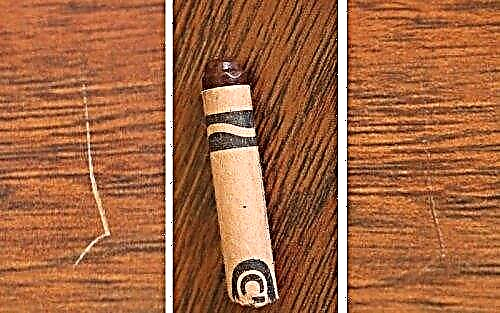
- To seal a hole in a solid wood door, putty is prepared. The constituent components are wood dust and varnish. A putty hole is hidden forever from the eyes. The filler adheres firmly to the wood and does not crack.
- After puttying, the surface of the entire sash is sanded with fine sandpaper. Dust residues are removed with a clean cloth.

- To freshen up the old interior wooden doors, choose drying oil, varnish, stain or paint. Paint and varnish material is applied with a brush, roller or spray. Paint the product only in a horizontal position to avoid the formation of leaks.
After the paint dries, fittings are installed on the updated sash and fastened to the door frame with new hinges.
How to restore a wooden door leaf?
Doing restoration of wooden doors with your own hands consists of three stages:
- Training. The sash is removed from the hinges, all accessories are dismantled, and the soft upholstery or paint layer is removed.
- Restoration. The product is putty in places of formation of a gap. Holes close up with putty. After hardening, putties pass with a grinder. The dust remains are erased with a rag. The prepared surface is painted.
- The final. The sash is hung with hinges on the door frame. Install the handle, lock, latch. If the beam is loosened, reinforce with anchor bolts. The gaps between the wall and the frame are blown with foam.
There are several options for restoring a wooden door:
- To restore the product, varnishedRemove the old coat of varnish to wood. Grind with fine sandpaper in the direction of the wood fibers. A new varnish is applied with foam rubber or a flange brush is used. The first two layers are coated at intervals of 3 hours. The third and fourth staining is performed in a day. In total, 4 layers are applied. After drying, the product is polished with felt.

- Veneer restoration provides for a complete cleaning of the product. The leaf surface and veneer are lubricated with contact adhesive. Billets are allowed to dry for at least 1 hour. For reliable bonding, you will need a press, but there is no such equipment at home. The veneer sheets are laid on the sash, quickly with a strong pressure they begin to overwrite with a wooden block. For reliable bonding, centimeter by centimeter pass. It is possible to use an iron heated to 50 ° C instead of a bar, but after this method, veneer swellings often appear.

- Old wooden casement glued with laminate or MDF panels. An iron or rubbing with a bar will not help here. The product is placed under a makeshift press.
- When restoring a hollow canvas, it insulate. After removing the panel, the pockets between the frame elements are filled with sawdust, mineral wool or other insulation.
- Entrance leaf made of wood is restored from the inside faux leather. The material is beaten with furniture nails, forming a pattern on the surface. To obtain bulges and additional warming, thin sheet foam rubber is placed under the skin.
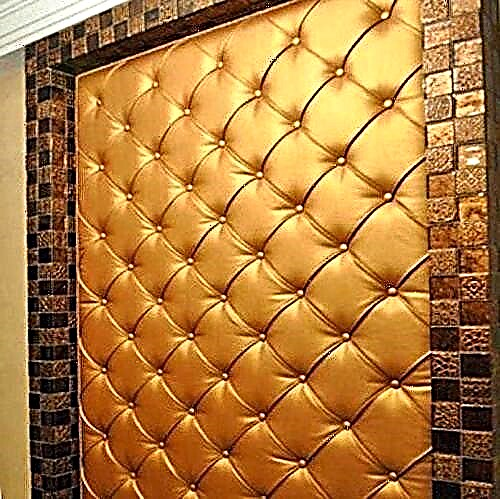
- Heavily cracked sash from the massif is restored by facing clapboard. Work requires an accurate fit of the workpieces. In the final, the surface is ground and varnished.
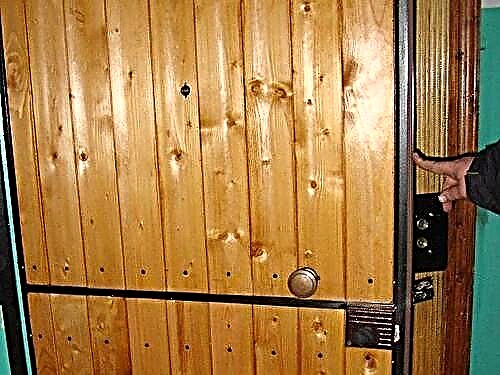
The most common recovery method is simple staining.
Paint Removal
Restoration of the door leaf cannot be started until the old paint has been completely removed. There are three ways:
- Warming up. To work, you need a heat gun. Another name for the device is a building hair dryer. Surface heating is carried out evenly. In one place it is impossible to warm for a long time so as not to spoil the wood. The appearance of burning already indicates a violation of technology. Softened paint is cleaned with a spatula.

- Mechanical removal. The method involves erasing paint with a grinder, grinder or drill with special grinding nozzles.
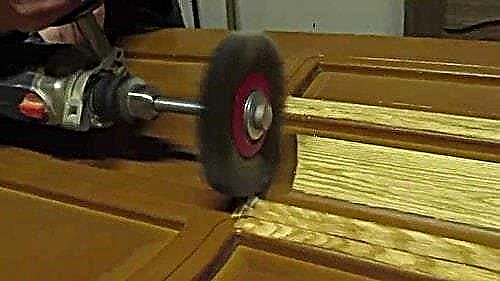
- Chemical cleaning. Removal of old paint with reagents is carried out in a well-ventilated room or on the street. During operation, use glasses and gloves. Chemical solutions soften the paint, which is then scraped off with a spatula and washed with a rag.

Of all the methods, mechanical removal is more often practiced. A chemical solution and a hairdryer will violate the wood if the cleaning technology is violated.
Grinding, hard putty and primer
After getting rid of the dried paint layer, the surface is polished. First I use sandpaper with large crumbs to remove paint residues, burrs, bulges. The door is wiped with a rag from dust. The second grinding pass is done with fine sandpaper. Dust is wiped off the treated web and the surface is degreased with a solvent. White spirit will do.
If polishing did not eliminate the cracks, putty is prepared into the deep pits of the door leaf, prepared from a mixture of sawdust with PVA glue. You can use store compositions. Dry putty rubbed with sandpaper.
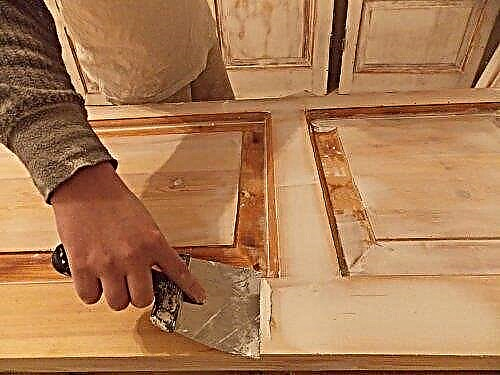
Before painting, the surface of the sash is primed. You can not neglect the process, otherwise the coating is unevenly absorbed into the wood. When using stains, the primer is not performed.
Coloring
There is a wide selection of paints and varnishes, allowing you to get a glossy, matte or semi-gloss surface. For interior door blocks apply varnishes and water-based paints. The front door is painted with alkyd enamel or nitro-paint. Stains allow the wood to remain natural.

The paint is applied in two layers on a horizontally laid canvas. A flat surface is easier to roll with a roller. The leaf with convex patterns is painted with a brush.
Restoring a dry door
If the product has dried up due to high temperatures, recovery involves disassembling the canvas. The purpose of the repair is to eliminate the gaps between the slats, and also to prevent the panels from hanging inside the grooves.
The frame elements of the panel door leaf are connected by a thorn-groove lock lubricated with glue. Additionally, long self-tapping screws can be used for screed. Hats on top are covered with decorative corks.

During the repair of an old wooden door, the sash is removed from the hinges, mounted vertically on one of the sides, the plugs are removed and the screws are unscrewed. The glue on the castle compound has long since dried up. The frame element is easy to remove. The castle compound is cleaned of the remnants of the old glue and proceed to repair the panels.
All inserts are removed from the frame. The grooves and edges of the panels are cleaned from glue. The door is thoroughly blown out with a vacuum cleaner so that the dust does not interfere with gluing. A thin layer of silicone-based sealant is driven inside the slots. After inserting the panel in its place, squeezed out excess sealant is wiped with a rag.
The locking joint of the frame is generously lubricated with carpentry glue. You can use PVA. The frame element is put in place, the door leaf is clamped with clamps, the screws are screwed into the old holes and the plugs are closed. In the clamped state, the web remains until the glue hardens completely. It is not possible to drill new holes for the dowels, since using a hand drill they will turn out at a slight angle. After uneven screwing of the nagel, the frame is skewed.

Decoration options
Restoration work is aimed at restoring the wooden sash, but then it needs to be decorated to the interior of the room. There are several popular ways:
- Canvas stain paintwork material suitable for the color of the interior. You can choose a shade by adding color to white paint.

- To make the entrance invisible will help wallpaper. Before gluing, the surface of the sash is primed. Wallpaper use the same for the room and door leaf. If you want to highlight the entrance, pick up tapestries of a different color.
- Decoration stencil allows you to create an exclusive product. On hard cardboard, images of flowers, animals or simply geometric shapes are cut out. The stencil is glued to the surface of the canvas. A foam pad is applied. After drying, the stencil is removed, and blemishes of the leaked paint are washed with a solvent.

- The easiest way to decorate is to decorate vinyl stickers. Shops offer a large selection.Bored stickers are easily removed, and new ones are glued in their place.

- False facades from MDF - A complex but effective way to decorate the door block. Fixation occurs with glue or self-tapping screws. The overlaid facade allows you to completely hide all defects.

During the repair of wooden doors with their own hands, the hardware is replaced. However, old door blocks are often equipped with rare hinges and handles. If the canvas is decorated antique, it is better to restore all the fittings. Traces of corrosion are removed with fine sandpaper. If desired, the accessories are stained with primer-enamel.
Restoration work takes a lot of time, requires investment of labor, finance. However, restoring the product is cheaper than buying a new unit. And do not have to change the size of the opening.
Possible problems and their causes

Construction restoration is not always performed. It is necessary to take into account the factor that contributed to the deterioration of the appearance of the door. It happens that changes in the surface of the sash and the structure of the material are irreversible. Causes of defects:
- Cracks. May appear for various reasons. For example, wood is prone to drying out. It is possible to renew old doors when destructive processes have just begun to develop.
- Peeling off the coating. The surface of the door leaf is deformed if it is sheathed with panels, sheets that are made of a different kind of material. This is due to low adhesion during fastening. Another reason is the natural aging of materials: they are deformed, dry out, which leads to delamination. In addition, varnish and paint may also peel off. It is necessary to update the front door in this case, since the absence of a protective layer will lead to an acceleration of destructive processes. Pre-removal of paint.
- Increase technologically clearances. This does not affect functionality, but drafts may appear. In addition, the adherence of the door leaf to the frame is reduced.
- Mashing the end sections of the sash. This occurs as a result of the swelling of the tree. Another factor is incorrect installation, due to which the sash could skew. Door mashing also occurs due to skewing of the door frame, which is a consequence of the aging of the structure and the material from which it is made.
- Excessive load on the frame. At the stage of choosing the door leaf pay attention to its mass. With this option in mind, loops are acquired. If the door was initially improperly selected, excessive loads act on the box, which will lead to loosening of this structure: the fasteners are loosened, as a result of which the sash ceases to function normally.
- The processes of decay. The reason is regular and prolonged contact with moisture. In such an environment, a fungus develops, which leads to a violation of the structure of the material.
- Scratches, chips. Such defects are more pronounced in the lower part of the sash. They arise due to careless operation: there are random blows, the door opens with a foot.
Determine the feasibility

In most cases, it is enough to refresh the structure: grind, re-apply the coating. Such manipulations are performed regularly every few years, because any material needs care, because it has the property of aging. Sometimes it is impractical to restore the canvas due to significant damage. If irreversible processes develop, it is better not to undertake door restoration. These cases include:
- The decay of the material, and pay attention to the intensity of the destruction of the structure. If the fungus has covered the canvas throughout its thickness, it is better to immediately change it to another. With a superficial defeat, it is possible to renew the interior doors, but first all the rot will be completely removed. This is more true for wood products, becausemetal strikes rust.
- Significant flaws: chips, bumps, skew design. In the presence of visible cracks, indentations on the surface of the door, it is impractical to restore, since it will have to remove a significant layer during grinding. If you try to restore such defects using leveling mixtures, the result may not live up to expectations, especially if there is no experience in such works.
- The base (door frame / frame) is used for a long period. Shabby structures cannot be restored, because the structure of the material from which they are made is gradually destroyed.
How can I do the restoration of paintings with my own hands?
When the doors lose their original appearance, the idea immediately arises of replacing it. Not everyone will decide to restore them on their own, considering such a process a long and tedious one. Do it yourself is beneficial in the following cases:

- the canvas is made of fine wood,
- if the interior is radically changing, then it’s enough to try to turn the old doors into something interesting or fabulous,
- the canvas has an original pattern (antiques),
- the door was custom made to custom sizes.
Material affects the way of restoration. Having understood the nuances, the update procedure does not seem too complicated and will allow you to have fun.
Below is described in detail how to update old canvases, also from Soviet times, from various materials.
Wooden
Made from solid wood. Usually the top layer becomes unusable. Therefore, the product is better to update than buying a new one for a lot of money. Painting is a great way to restore wood. The selection of stains and varnishes is huge. Choosing a favorable shade is easy. It is important to remember the rule: the darker the paintwork, the better the damage and defects are masked.
PVC
They are not always attractive, especially in the presence of strong pollution and yellowness. Cloths in adverse climatic conditions quickly deteriorate, lose their original appearance. You can update the design:
- Staining.
- The first stage is the cleaning of plastic from stains and films with special cleaning agents.
- Then add hardener to the paint.
- Carefully apply the mixture from the spray gun.
- After drying, add another 2 or 3 layers.
- Vinyl wrap. A simple way to decorate a damaged surface. In stores, the range of films with all kinds of drawings or ornaments is widely represented. Before decal you need to degrease, clean the surface. To prevent air from getting under the new pattern, just wipe the cloth with soapy water. It is easy to stick a vinyl film:
- fix the pattern in the desired area,
- remove the base
- iron the pattern with rags.
- Veneer. Converts plastic to wood.
- The surface must be cleaned, degreased, dried, and the protective layer removed from the veneer.
- Attach panels, glue with an iron.
Instead of laying it is better to use a dense fabric so as not to damage the material.
From fiberboard
Refresh wood chipboards can be painted or pasted with veneer panels. The technology is no different from the procedure for restoring a plastic sheet. However, it is forbidden to process the material with a soldering iron or sandpaper with coarse grain. To remove the old coat of paint, use fine sandpaper (No. 90–180) or a building hair dryer.
Putty application
Putty - an affordable method of updating the door leaf. The substance is available in different shades. The desired color is selected according to the style of the room and the preferences of the owner. Putty mixture can be applied according to the following instructions:
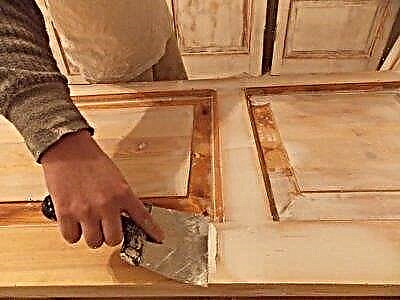
- Remove the old coat of paint.
- Sand the surface with sandpaper so that the movements are made along the line of the fibers. Sanding will remove paint particles from hard-to-reach places, smooth out scratches, chips.
- Vacuum the surface, wipe with white spirit for degreasing.
- Apply a thin coat of primer. It will increase the service life, will become the basis for a new paintwork.
- Apply putty with a spatula, spreading evenly over the entire surface. Wait until the layer is completely dry.
- Finish fine-grained with sandpaper to remove any remaining defects.
Strengthening
This method is not suitable for PVC. The reinforcement procedure consists in adjusting the geometry of the door leaf. Required with strong drying of the wood, loose closure. Here are some tips for strengthening:
- Remove the excess from the deformed panel with a plane, but take into account the size of the doorway. Otherwise, there is a risk of cutting more material and permanently ruining the structure.
- If the door has cracked, there is a significant gap between the frame and the door itself, it is extended with a rail of the required size. For a precise fit, use a file or a planer.
- Fix the door elements to each other with metal or decorative carved corners.
Additionally processed jambs and door frame. If the door frame is in a terrible state, then in this case both painting and veneering will help. The method of restoration of the box depends on the material, the previously selected method of updating the entire structure.
Cracked glass replacement
Door glass bursts from sudden changes in temperature or careless handling. Sometimes it is necessary to replace the old muddy element with a new glass - frosted, transparent, tinted, embossed, smooth, colored, plain or with a sandblasted pattern. This is easy to do if you use the following tips:

- Glass with glazing beads.
- Pry the glazing bead with a metal spatula, carefully pull out the carnations with pliers. Remove the glass with your hands.
- Scrub the bed with a chisel or knife.
- Measure the opening, make a piece of cardboard (note that the dimensions of the new glass should be smaller than the opening).
- Wipe the new glass element with a sponge dampened in soapy water. Dry thoroughly with a clean cloth.
- Transfer the pattern, cut the glass.
- Process the opening with sealant, insert the cut out piece, secure with new glazing beads (fix with small cloves).
- Glass with hidden fixation. Here you need to disassemble the door, unscrew the bolts, remove the glass and insert a new one. It is not recommended to use sealant. This method has a significant drawback - the door after assembly will lose its geometry, will require processing with a planer.
Regular glass can be replaced with decorative acrylic. It is much lighter, stronger, more convenient to handle. Its price is also affordable.
Is it possible to upgrade laminated?
You can update them by painting or gluing veneers. But to restore such a canvas is very difficult - it practically cannot be processed.
It is forbidden to use stain, varnish. Before applying paints and varnishes it is necessary to putty the surface. Ready putty will be visible through the varnish coat.
Paint application is also a bad decision. She will roll on a smooth laminate, and later she will peel off. The doors will look even worse than before the restoration.
Gluing veneers or PVC films are the best ways to renew a laminated surface. Recommended:
- good to clean it from stains, fat,
- and then attach decorative elements.
Painting and decor
Before painting, degrease the door leaf, clean from contamination. To paint in two stages - applying the main layer of white paint, and then tinting.
Tips:

- Apply paint with a spray gun or brush, moving along the fibers. You can apply another layer, preventing the appearance of smudges.
- For tinting, it is better to take glossy or matte paint. Choose color yourself. Painting is performed similarly.But do not get carried away, create a thick coating (it will be difficult to remove it during the next repair).
After the layers have completely dried, apply a glossy varnish. To protect glass, accessories with masking tape. To give the door leaf sophistication, just connect the imagination. Drawings, patterns should be in harmony with the interior of the room. The scenery can be applied:
- with a brush
- PVC film
- stickers
- paper
- unusual baseboards.
We offer you to watch a video on how to properly paint the door:
Overhead facades
Interior doors are not always amenable to restoration. In this case, you can change the facade. Decorative elements are made of different materials, but masters advise you to choose linings from MDF. Benefits:
- moisture resistance
- long service life
- don't lose their shape
- a light weight,
- attractiveness, accessibility.
They are fixed to the panel with self-tapping screws or PVA glue. Decorative facades adorn the interior, give them solidity. Looks great regardless of material.
Stencil Drawings
Stencils are a popular way of effectively transforming any old door. Templates can be bought or created with your own hands. Stencil drawing is performed according to the following instructions:

- Surface preparation.
- To clear a cloth of pollution, spots.
- Remove fat with soapy water and dry thoroughly.
- Coating with paints and varnishes.
- Apply varnish or paint of the desired shade.
- Wait for it to dry.
- Dressing.
- Attach a template to the prepared surface, fix.
- Paint over empty areas inside the stencil.
- At the end of the work, remove the template, wait until the paint dries.
Additionally, you can draw contours in a different color. The picture will look more voluminous, more interesting. Fill the voids with only a small brush, so that the work is much more accurate, more beautiful.
Wallpapering
Refers to more attractive, inexpensive methods. The method can be performed every month or year. The instruction is as follows:
- Primer. Apply the mixture in one coat. Wait for complete drying.
- Wallpaper preparation. They can be glued in a solid piece or cut out individual patterns to create a unique pattern - it depends on the imagination, the wishes of the owner.
- Pokleyka. Here you need to prepare an adhesive solution for wallpaper. Put it on the panel, firmly fix the wallpaper.
Wall murals are also popular. Their price is higher than that of standard rolls, but photo prints have a significant advantage - the beauty of the picture. There are many variations:
They emphasize sophisticated design.
We offer to watch a video on how to paste a wallpaper on a door:
Updating the canvas at home
You can update the door by radically changing its appearance. For example, you can increase the number of glasses or change their location. The process is time consuming, requires effort and patience. Stages:
- Surface preparation. Remove paint with fine sandpaper. Act carefully.
- Remove the glass. Close the holes with plywood. Make cuts in the desired sections of the canvas.
- Primer, putty in places with defects. Wait for it to dry. Then apply a thin layer of varnish or paint so as to hide the presence of plywood.
- Install new windows in new openings. If necessary, cut the elements to the desired dimensions. Fix the glass with glazing beads. Instead of glass pieces, you can use decorated panels.
It is recommended to perform additional decor of accessories:

- It is enough to grind the element, apply a primer enamel. She will emphasize the beauty of the ornament.
- Wait until it dries, fasten the handle back.
Another interesting way to update the panel is the use of fabrics. This is a very original, extravagant and young idea. The fabric can be replaced:
- posters
- cards
- photographs
- notes
- other fantasy elements.
Glue the material to the panel with construction glue.
Necessary tools and materials
Here is a standard set of tools and materials that are necessary for any type of repair work. The list may vary depending on the restoration method:
- solvent (must correspond to the coating material of the panel), paints and varnishes (varnish, stain, paint),
- building hair dryer, soldering iron, iron,
- fine and fine sandpaper
- grinder, planer, vacuum cleaner, putty knife,
- clean rags, brushes, rollers, spray guns,
- screwdriver, hammer, knife, glass cutter, pliers, film, masking tape,
- glue, putty, primer,
- decorative materials to choose from - veneer panels, wallpaper, fabric, facades, glass (ordinary or acrylic).
If you decide to replace accessories, then you should buy new ones:
- door handles,
- locks,
- glazing beads,
- loops
- small cloves.
Good examples and interior options
Interior doors - the face of the house. Their design reflects the taste and character of the owners. It is important that the design of the panels is unique, interesting, creates a welcoming atmosphere. If the canvases are boring, faceless, then they will deprive the room of individuality.
Here are some good examples of door and interior design:

- Art painting. Hand-painted interior doors look amazing. If the owner of the house or apartment draws well, it is easier for him to create intricate plots or a unique pattern. The interior will resemble the royal chambers.
- Wall mural with 3D effect. Volume abstractions are gaining popularity very quickly. Wallpaper emphasizes the depth of the architecture of space, and their plots give the interior expressiveness. They look beautiful, expensive. The gluing process itself will not cause difficulties - they are fixed, like ordinary wallpaper, on a special glue.
- Combinations For example, the decoration of the openings is made of decorative stones, and the canvas is made of mosaics. Another option is painting with the presence of stucco elements or with decor from rivets.
- Fabric, leather trim. Today, interiors from shabby chic to retro are once again popular. The canvas can be decorated with rivets, combinations of different shades, supplement with accessories or make “sewing stitches” with a construction stapler.
- Stickers. The most affordable way to decorate. Advantages - easy application, masking of defects, lack of traces. Typically, stickers are used in children's rooms. In the shops there are products with cartoon characters, attractive compositions for boys and girls.
- Solid color. This option helps to correctly place accents in monochrome interiors if the door is painted in a bright color. Having tried to paint the canvas in one of the main shades of the interior, you can support the overall color palette.
Restoring interior doors is easy. Enough:
- be patient
- good mood
- correctly prepare for the selected method of updating the banner,
- purchase materials
- prepare tools
- Use the advice of the masters.
If you connect a fantasy, you can create:
- unique atmosphere
- unique interior
- luxurious style.
If the house is dominated by a harmony of colors, there are neat interior doors, there is always a friendly atmosphere and home comfort.
Preparation for work

Do-it-yourself restoration of interior doors begins with the dismantling of the canvas. If necessary, remove the box, platbands, slopes. This is done when the base of the door structure also requires restoration. The sequence of steps in the preparatory phase:
- The sash is removed from the canopies. Often enough to move the canvas upward. In rare cases, dismantling requires the removal of fittings. For this, drilling of fasteners is performed.
- The door leaf is placed in a horizontal plane.At the same time, structural stability is important.
- Remove the doorknob, other fittings.
- In most cases, removal of the old coating is required: panels, upholstery with soft materials, a layer of paint / varnish.
- Plastic doors just need to be washed thoroughly.
- All contaminants are removed. You can use a vacuum cleaner, a broom. If the door is wooden, it is not recommended to use the wet cleaning method, because the sash will swell under the influence of a liquid, and in such conditions it is impractical to take measurements.
To update a wooden door, it is necessary to prepare the tool. It will be required:
- chisel,
- hammer,
- nail puller
- Sander,
- hacksaw,
- drill,
- screwdriver
- sandpaper,
- plumb bob
- building level,
- gon.

At the next stage, you need to decide on the technology of restoration. Then the necessary material is acquired, for which the canvas and the box are measured. You should not be guided by the standard dimensional grid of the manufacturer from whom the product was purchased, since over time the wood dries out, deforms. In the manufacture of plastic and metal doors, there may be errors, which means that in this case too, it is necessary to obtain valid measurements.
How to restore a wooden door?
It is necessary to adhere to a clear sequence of actions. To renew wooden doors, remove the old coating. Structures made of this material always protect something, whether it is paint, varnish, dermatin, leather, panels of various types (veneer, plastic, MDF, etc.). If the coating is not dismantled, it will not be possible to return the canvas to attractiveness, since the main task in this case is to remove defects from the rough surface of the door.
Before starting restoration work, the product should be prepared. At the first stage, the condition of the box is evaluated. Restoration of an old wooden door cannot be completed to the end if the frame has remained untouched. First, the design is checked for distortions, for which they use plumb, the construction level, squares. To level the box, remove slopes, platbands. The frame is strengthened in two ways: pins, additional fasteners, for which perforation of the partition is performed (the method is suitable for load-bearing walls).
Small scratches from the cloth are removed with sandpaper. Larger defects can be eliminated by grouting for parquet scraping, and puttying. The mixture is applied to the surface with a spatula. A more complex reconstruction process, when you need to remove a hole in the canvas, is carried out using a mounting foam. It is important to preserve the color and structure of the tree, so it is recommended to select compositions of a suitable shade. When the substance dries, the surface is treated with sandpaper.
For small but deep damage, an alternative method is used - dowels. At the point where the hole in the door, a hole is drilled. Then set dowel, pre-treated with an adhesive composition. It needs to be driven into the canvas, thereby increasing the reliability of fastening. At the last stage, this area is processed by grouting or puttying.
Removing old coating
To update the interior door, it is mandatory to remove varnish or paint. Over time, the coating peels off, so repeated staining will ruin the door, because the surface will be heterogeneous. Any solvents are used to remove paint / varnish layers, there are special tools or flushing compounds. They are applied to the product, wait a while and remove the exfoliated film with a spatula.

Old wooden doors can also be renewed mechanically; for this, a sharpened plate is used to peel off the coating, and also sandpaper. Use the method of heat exposure (building hair dryer, soldering iron).
How to update using the usual elimination of chips and cracks?
In this case, it is advisable to use putty, special wax or epoxy glue. The last option is to fill the gap flush with the surface of the canvas, otherwise the door will look less attractive due to uneven coverage. All scratches of small depth can be removed with wax or epoxy glue. Moreover, it is desirable to select the material used, taking into account the shade of the canvas. If this is not possible, it is better to cover the sash with varnish or paint. Old wooden doors are updated according to the instructions:
- leaks, crevices clean from dust,
- filled with putty,
- level the surface with a spatula,
- polished.
Painting

After the preparatory work has been completed, and the canvas is leveled with putty or other material, they proceed to applying the finish coating. The painting process should be carried out in a well-ventilated room or outdoors in dry sunny weather. If you are doing the restoration of a wooden door with your own hands, you should follow the instructions:
- Work begins with dust removal and priming.
- Apply paint / varnish. This should be done in stages, allowing the material to dry completely. It is enough to leave the door in a well-ventilated room or in the sun for 24 hours. This eliminates the likelihood of smudges. To make the coating look attractive, the door is treated with a paintwork composition along the direction along the fibers. It is recommended to apply several layers. Moreover, at each stage, the surface must be ground. To do this, use fine-grained sandpaper.
- If you are interested in the question of how to make a modern door an old one, you need to know that the most optimal option is to tint with colored paint on top of a white matte finish.
Replacing glass and creating a stained-glass window in the interior
The procedure can be performed in two ways, the choice depends on the design of the canvas:
- Dismantling of special elements (quarters) or glazing beads. At the same time, you can transform the door without disassembling the sash, because this is not provided for in such designs. To remove quarters or glazing beads, you need to pry them. Then the fasteners will also be pulled, often these are nails. Then remove the old glass, install another in the grooves and fix it in the same way.
- You can update the old interior doors by dismantling the hidden fasteners connecting the 2 halves of the leaf. In this case, external fasteners are not used, and the glass is held between the halves of the sash in the grooves.
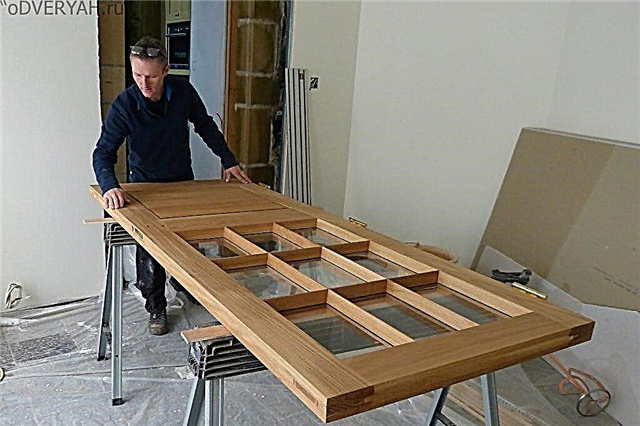
Stained-glass windows are created in different ways:
- sandblasting technology, which is difficult to do at home,
- applying stained glass film, but the effect will be unrealistic,
- painting.
Varnishing
This method is suitable only for the case when the canvas is in good condition and does not have significant defects. To update the wooden interior doors, alkyd, acrylic, polyurethane and nitro varnishes are used. They should be applied with a roller, which will allow you to get a uniform layer. The primer is used carefully, because it can slightly change the shade of the tree. The principle of varnishing is similar to staining, but there must be at least 3 layers. After applying each of them, the surface is ground.

Photowall-paper
The type of finishing material must be selected taking into account the degree of damage intensity. If cracks and chips are large enough, textured wallpaper is used. Smooth coating will not hide obvious defects. Glue is selected according to the type of finishing material. It is better to use the option, which contains antifungal substances. The door is updated according to the instructions:
- The sheet of wallpaper is turned face down. Sometimes, to glue the door, it is cut into pieces.
- Both wallpaper and canvas are treated with an adhesive composition.
- The principle of gluing is the same as in the case of wall covering: the sheet is smoothed from the center to the edges. Excess glue is removed with a sponge.

Secrets of restoration
To be able to ennoble the canvas, you should learn more about restoration work. The main subtleties:
- When choosing a method for eliminating a defect, its length, width, and depth are taken into account.
- Grout, putty and other compounds leave spots on the surface of the wood. If you want to cover the sash with varnish, shallow chips are removed with a plane.
- Restoration of wooden doors is made taking into account the interior of the room: the shade of the grout, paint and varnish materials must match the design of the object.
Refreshing old fiberboard
To remove the coating in this case, it is not recommended to use a soldering iron and coarse sandpaper. The warm-up method with an iron wrapped in fabric has a positive effect. Fiberboard - demanding material, it does not tolerate aggressive effects. To renew the door, you can use the staining method. However, a simple veneer will help make the canvas much more attractive. Panels pane the door leaf.
We give new life to plastic
Such a canvas lasts longer without losing attractiveness, which is due to a smooth surface, sufficient strength, ease of care. Available options for updating PVC doors:
- staining, and it is recommended to use water-based polyurethane compounds,
- pasting with a vinyl film,
- restoration of PVC interior doors is also carried out using veneer: panels cover the fabric from all sides, as a result, a product is obtained that resembles a wooden analogue in external characteristics.

We remake metal
There are several options, and all of them are universal and can be used to finish the canvas from any material. It is not so easy to damage a metal door, therefore, in most cases, grinding is enough, but provided that it is not touched by rust. Available finishes:
- pasting with PVC film, self-gluing is applied or the material is fixed with varnish,
- MDF panels, their fastening to an iron door is carried out by means of self-tapping screws.

Metal sashes are much less commonly installed indoors. The entrance doors are also finished with dermatin / leather.
Installation of new fittings
Another handle, hinges, awnings, locking mechanism, if provided, should be installed on the restored canvas. Metal elements tend to wear out, so old fittings will spoil the appearance of the sash in the apartment with a fresh repair. The locking mechanism is recommended to be selected taking into account the configuration and dimensions of the existing hole in the door. Drilling other attachment points may compromise the integrity of the lining, and work will have to be started again.
The subtleties of the process
Old or damaged interior doors are subject to restoration. The cause of mechanical damage can be, for example, a fire. High humidity can also adversely affect a wooden canvas. Often mechanical damage occurs after opening the door using improvised tools. When restoring the product, door leaf replacement, door jamb updates, painting or tinting of the surface may follow.
To renew functionality, it is often necessary to upgrade hardware or locks. With minor damage to the interior doors, restoration work can be done with your own hands.

Repair of original doors is best entrusted to a specialist in this field. Work should also be left to a professional if restoration requires replacing the door jamb or repairing the entire door frame as a whole.
For acquaintance some advantages and features of restoration of interior doors are presented:
- Doors made of solid wood are beneficial to repair, bringing in a proper and working form, rather than spending a budget on a new product.
- Update the old door when changing the interior style in the house. The procedure is carried out even when the canvas is still in excellent condition and does not yet need to be replaced.
- Restoration of old wooden structures is carried out when the canvas and door frame handmade, have a unique ornament and texture.
- Making the door surface with your own hands will create a unique product that harmoniously decorates the entire interior.
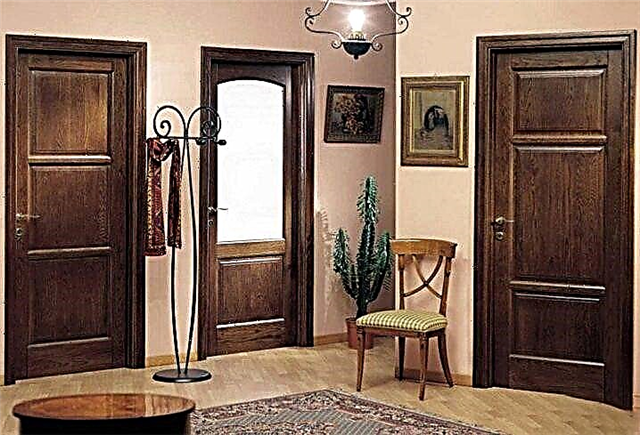
- The interior door must be repaired when, due to the replacement of the door, the integrity of the opening or wall cladding may be impaired.
- Due to the non-standard size of the old door, it is better to carry out restoration work than to carry out laborious replacement of the product.
- Restoration is convenient, as the replacement of the product is often accompanied by a change in the entire door frame. This procedure will unambiguously create the need to close up the formed cracks, plastering and gluing wallpaper around the doorway.

For independent work you will need a lot of free time. The phased execution of all procedures will be the key to successful restoration of the door leaf.
The successful application of product restoration techniques primarily depends on the characteristics and properties of the door leaf material.
Materials
Previously, interior doors were made exclusively from an array of natural wood. Currently, the composition of the door leaf includes polymers, glass. The surface can be coated with high-quality varnish, or laminated. Oak doors or beech wood products are premium door leafs that have a graceful natural texture and different shades.
Increased strength and durability make such interior products desirable and practical. Only the price due to these advantages is very high. Carrying out restoration work much more economical to replace the entire canvas.

A demanded material in the manufacture of paintings is a fiberboard. The methods of restoration of such doors differ from the restoration of products made of solid wood. To remove a layer of old paint from the surface of a fiberboard product, an iron and a building hair dryer are used. Given the fine structure of the surface of the product, the grinding work is carried out only with a fine skin.
With the help of finishing elements, changing the surface relief a little, you can get an analogue of a paneled canvas. Expensive models consist of dense tile material. High-quality surface finish of the product determines the cost of the product.

Often, gluing from innovative veneers is applicable. The basis of the door will be inexpensive pine material, lumber or chipboards. Under the influence of temporary changes, veneered products can lose the integrity of the upper layer. For the restoration of such doors requires a special carpentry glue. When using glue It is also necessary to take into account the favorable temperature regime and to avoid humidity. Violation of this mode can negatively affect the veneer surface, which leads to swelling and delamination of the material.

For an amateur, the use of metal structures in the house. Iron doors also tend to wear out, unless, of course, these are armored products. Even on high-quality canvases, the external finish deteriorates over time, locks break, accessories crumble. Long-term operation significantly affects the appearance and design mechanism of such doors. In iron interior structures, aluminum or stainless steel is mainly used. Metal parts are successfully combined with other materials.

If you purchase a new door, then high-quality metal products are expensive. Therefore, it will be much more profitable to repair the old door. According to the experience of professionals, it can be noted that any options for metal doors lend themselves to restoration. Professionals can replace the hinges, handles and lock in accordance with the color scheme of the door leaf to be restored.
For the correct completion of the restoration, it is recommended to use only high-quality components and locks. From this selection will depend on the further life of the product.

Options for different models
With antiques you can safely reckon the "Stalinist" door. Indoor products of this era are usually bivalve, often with glass inserts. In the "Stalin" products are heavy and bulky, which makes it a little difficult to work on their restoration. A professional master will be able to easily choose modern material for their cladding, the necessary fittings and type of decoration.
Door leaf and the surface of the historical "Stalinist" doors are usually wooden. If the cause of the damage is not a mechanical effect, then scuffing is the effect of time. Refurbished wooden doors should have an aesthetic appearance. Masters will help you choose the basic material and decoration, give a concise look to the ancient doors.
In an apartment with an atmosphere of Provencal or Scandinavian style, the restoration of the doors is also decorative. Decorating with patina and murals will turn a plain old white door into a stylish decoration. The presence of frames and beams characterize a prefabricated interior door, which is also called paneled. For example, panels can be in the form of sheets of MDF or glass inserts. So it is possible to create curly elements and make the appearance of the canvas quite interesting. Restoring panel doors means preserving existing reliefs or completely replacing the surface of the product.

This option is suitable for offices, bathroom and toilet, balcony and other rooms with high humidity. Economic and moisture resistant models are indispensable for such rooms.
Glass is often used as an insert; there are also options for completely transparent doors for the newfangled interior of a living room, for example. Only special types of glass paintings are used in texture. For safety reasons, the material should have a protective film, not form sharp fragments when broken, which is also taken into account during the restoration of such paintings.

How and what can be updated: ideas
Various materials are used to repair and decorate an old or damaged door. The color scheme of the material provided is also diverse. It is better to entrust the specialist in this field with complex work on door restoration and surface decoration. Eliminate minor scratches and simple work on decorating the old surface can be done on their own.
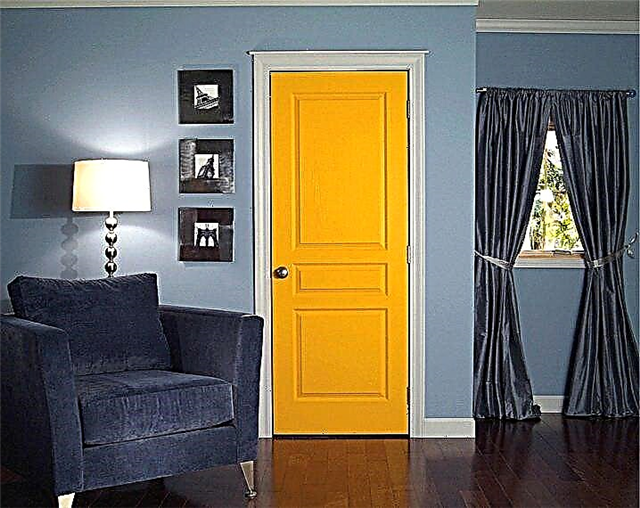
An easy way to update the door is surface painting. Everyone can paint the surface. Both for painting and for other types of restoration, first you need to prepare the surface of the product. Cleaning and freeing the surface from the old coating will be the first step in the restoration of the product. A fine-grained skin will perfectly clean it of old paint. After small cracks and scratches are smeared, then the type of coating and decoration elements are selected.

For painting in one color, acrylic paint is offered. In the case of restoration of a wooden door, paint and varnish are selected for work on wood.
Painting in several colors is a more complicated process. To do this, using masking tapes on the decorated surface, different shapes are created. After applying paint on top of the created picture, an interesting geometric ornament is obtained.Different colors can be created by adding dyes to the white base. The existing surface tinting method will help create the effect of the presence of the most expensive wood species in the canvas.
Special tinting impregnations - stains, will give the wood any desired color. As a rule, these are tones of elite tree species. Due to this, the pine coating can be given a visual resemblance to a walnut canvas. Of course, it will only be external. Such a property as moisture resistance, resistance to decay in this process are not acquired.
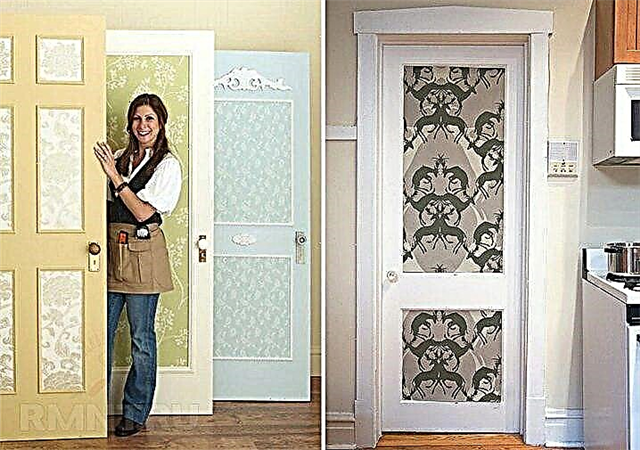
When painting, the moment is taken into account that the tree during processing has the ability to slightly absorb paint. Therefore, it will be necessary to apply another layer.
When working with paint, you can create not only plain doors, but also whole compositions. Designers according to the original sketch will be able to recreate any drawing if applied through a stencil. The idea of restoration in the form of artistic painting is also better to entrust to professionals, since artistic skills are indispensable here. Additionally, you can do the protruding parts, that is, moldings. They are also painted. For the original effect, they can be decorated in a contrasting tone.
In the case when the door is flat, without relief and moldings, you can imitate their presence with an ornament or stick polyurethane carved battens. Reiki must first be painted in the desired color.

The next stage of decoration is the design of doors with wallpaper, fabric. In this case, there are no special restrictions, since almost any images and materials of different textures can be glued to the door. First of all, you can pay attention to the photo wallpaper, which is abundantly presented in specialized stores. Any paper materials, as well as standard wallpaper can also be useful.

It must be ensured that the material is not too transparent. Otherwise, glue or hidden reliefs will come out. At the end of the installation, it is recommended to apply a layer of varnish by gluing with wallpaper, fabrics or paper. Such a coating will protect the door surface.
Many models of interior doors have glazed windows, which is why stained glass windows are very popular. Special stained glass paint is used to apply drawings and ornaments to a glass surface. For independent work, materials for painting and stained glass are purchased in any special store. Drawings can be transferred to glass using sandblasting. In a specialized workshop they can simply do such a job.

Sticking vinyl stickers as a way of decorating and restoring the product is one of the simplest procedures. Vinyl door stickers are sold almost everywhere. The protective coating is removed without difficulty. Without preliminary preparation, a film is glued to the door leaf. After the work is completed, the protective film on the outside is also removed. It is worth considering that vinyl stickers can even be painted.

Decoupage technique is also simple in execution and makes it possible to hide minor defects. In the process of this decoration, pieces of material, paper, napkins are collected in a single semantic picture, glued to the surface and varnished.
The option of finishing by building a picture from a mosaic is original and not expensive, in the process, fragments of ceramics, glass, wood, veneer are used. In addition to standard methods of restoration of interior doors, you can apply an extraordinary way of registration. Doors are updated using various bulk materials. When pasting the surface with cereals, such as rice or buckwheat, an exclusive and original work will be obtained.
To fix the grains, you can purchase PVA glue. After complete drying, the surface is recommended to be varnished several times to protect against moisture.Given that the cereal is dry in consistency, does not rot and does not deteriorate, and the varnish coating keeps the composition from moisture, there is no doubt about the durability of this design.

Recovery Workshops
Minor damage can be repaired on their own and at home. To do this, you need to properly prepare the tools and materials for restoration. The stages of work are as follows:
- At the initial stage the door must be carefully prepared. For this, the characteristics of the material of manufacture are taken into account. Mostly, wood products are subject to wear. If the interior doors are covered with veneer, for working with the surface of the door leaf a wax soft in consistency is acquired, as well as a special varnish and a tool in the form of a spatula. For wood products, hard wax and coarse sand are required.

- Before starting work carefully remove the door from the hinges, fittings and the locking device. If there are glass inserts, they must also be removed, as all fasteners will be dismantled. Restoration work with the door is best done indoors with adequate lighting. Before placing the product in the workplace, it is necessary to protect the flooring, as there is a risk of damage, as the paint from the damaged product will be removed under the hot stream of air from the hair dryer.

- From the surface of the door you need remove dirt by washing it with soapy water. After the door is inspected for the presence of significant defects. Minor scratches can be filled with putty. Next, the wooden cloth is wrapped with a flannel rag. The process begins with grinding the surface with the removal of excess wax with solvents. Further, the surface is recommended to be varnished.

- In any case, during the restoration of a door with a painted surface old coatings must be thoroughly cleaned. Do it yourself is much easier than it might seem, since the only necessary tools for work are a spatula and a building hair dryer. The latter is not necessary to buy, at the present time it can be purchased for rent. If door decoration is to be carried out in the future, the platbands and the door frame should be remembered. They also need to be trimmed to the color of the door itself.
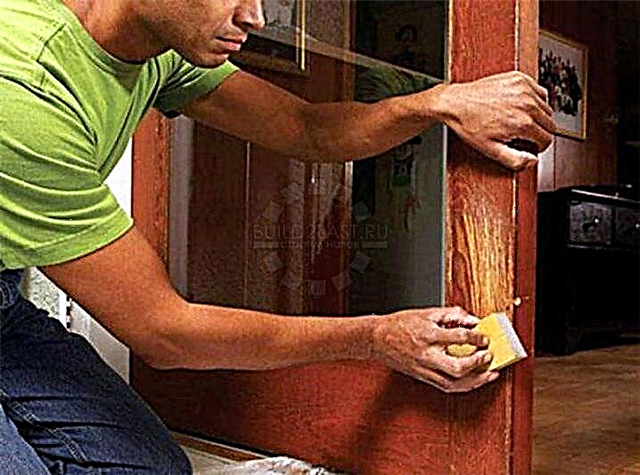
- After removing paint the surface is examined for scratches and other damage, they can be sealed with both putty and specialized putties for wood. The final stage of preliminary preparation is sanding and grinding the surface with sandpaper. In order to protect the door from moisture, the embedded surface is treated with drying oil. The same stain also has the usual stain, which in addition to protection, will give the surface a natural color.
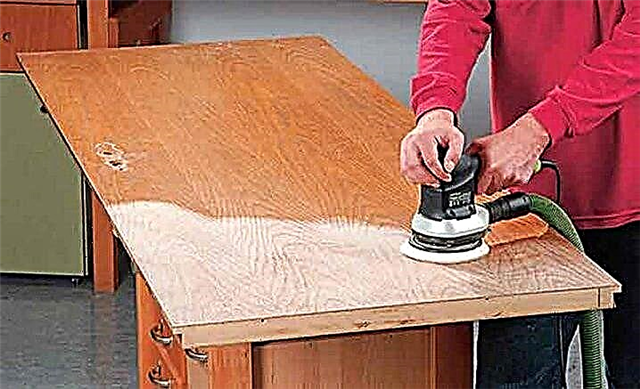
Restoration work can be carried out independently, but only a professional can correctly carry out the preparation of the canvas, clean, apply the base and decorate, after which the interior door will shine with new colors.

About how to restore interior doors with your own hands, see the next video.










